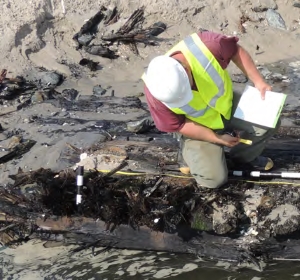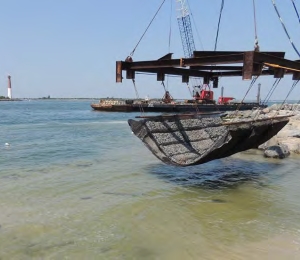Actions Taken to Preserve the Barnegat Inlet Wreck
Given the nature and scope of the surviving vessel remains and the necessity for burial of those remains under the jetty structure, a Research Design based on systematic archaeological documentation and data recovery was proposed. This Research Design was focused on the in situ documentation of the archaeological record and surviving physical evidence at the wreck site, along with recovery and conservation of diagnostic artifacts. The Research Design contained numerous aspects and consisted of both on-site and off-site activity. On-site activity consisted of archaeological monitoring of jetty construction, assessment and documentation of debris, in place documentation of vessel remains, and on-site artifact recovery and stabilization prior to conservation. Off-site activity consisted of artifact conservation, archival research, public interpretation, and long-term disposition of conserved artifacts.
 A portion of the hull showing splintered frame tops
A portion of the hull showing splintered frame tops
Because the possibility existed that additional significant historic resources were located in the vicinity of the ongoing construction, in concert with the fact that the currently known site had not been fully delineated, monitoring of construction activities were to occur from station 23+50 seaward. In the event that unexpected potentially significant resources were identified, the monitor was to immediately cease construction and contact the USACE Cultural Resources Specialist who would then notify the NJSHPO within 24 hours of the discovery. Additional resources besides the one wreck site, however, were not encountered.
Data Recovery
Prior to recognizing the remains as a shipwreck site, a substantial collection of various timbers, beams, fragments, hardware, fasteners, frames, and so forth, had been recovered from the site and placed at several locations within the construction compound. The majority of the vessel timbers was concentrated in a large debris pile that was spread out by heavy equipment for ease of documentation. This debris was analyzed for relevant fragments of historic resources, which was then be subject to baseline documentation.
In addition to the documentation of the existing previously removed debris and vessel timbers, the remaining in situ vessel structure was examined and recorded to the extent allowed by the environment in which it sits. A primary goal of the recordation of extant remains was the physical examination and documentation of vessel construction. Since the vessel structure is buried beneath sand and jetty structure, subsurface testing and excavation was used to delineate and expose the structure for recording. When construction commenced at the portion of the jetty under which the wreck is situated, removal of the jetty structure over the site was monitored so the site could be exposed. The vessel was cleared of sand using a water jet where practicable.
A detailed investigation of the vessel was conducted to determine exact horizontal site limits, detection of artifact densities, and assess the relationship between vessel and vessel components. Detailed drawings were made of the site to illustrate the location of artifacts, structural components, machinery, and hull lay out. Documentation was designed to address the following to the extent possible given the location of the vessel with respect to sea level and remaining jetty structure:
- Documentation included three-dimensional recordings of the hull design and construction features where practical. A plan of the surviving deck structure was made and the configuration of the bow and stern recorded.
- Identification of maximum length, beam, and draft and/or depth of hold if extant.
- Detailed descriptions of vessel construction and repair techniques, components, and materials.
- Scantling list (i.e., measurements of construction components, floor futtock, hull planks, etc.).
- Wood samples of various components for the purpose of identifying species and possible place of construction.
- Recovery of diagnostic artifacts.
Artifact Conservation & Reburial
Certain artifacts determined to be diagnostic in nature with respect to the Barnegat Inlet vessel were recovered subject to limitations on total cost of conservation and curation. Because recovery of diagnostic artifacts required a method of on-site stabilization due to the fragile nature of the recovered items, on-site stabilization of artifact material included submersion in fresh water. Recovered material was cataloged, tagged, documented, and shipped to laboratory facilities for conservation.
 Rock-filled mats used for reburying the wreck
Rock-filled mats used for reburying the wreck
Ultimate conservation of the artifacts was conducted by the Conservation Research Laboratory (CRL). The CRL is part of the Center for Maritime Archaeology & Conservation, at Texas A&M University. The CRL is one of the larger artifact conservation facilities located in the U.S., and has been in continuous operation since it started in 1978. Upon completion of conservation, all artifacts from the Barnegat Inlet shipwreck were returned to the USACE, Philadelphia District archaeologist.
Upon completion of the data recovery of the in situ main area of wreck, as well as the recordation of the stern deadwood and rudder, the wreck area, along with the redeposited deadwood and rudder at the main wreck area, were reburied beneath the jetty. The area was dug out to sand with all rock removed. Then rock mats were placed over the top of the wreck area and formed the base for subsequent jetty rock. This method was employed for the entire repaired area and not just at the wreck location.